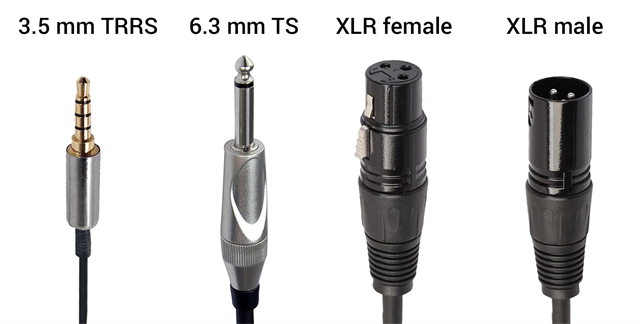- Sale
- 360 Degree Photography
- Battery and Battery Grip
- Backgrounds Even Color
- Backgrounds with Print
- Background Systems
- Cameras
- Camera Accessories
- Camouflage
- Continuous and Videolight
- Filters, Converters and Rings
- Photo frames
- Clamps and Adapters
- Cases and Bags
- Bulbs
- LED Lighting
- Magnifying Glasses
- Macro Photography
- Microphones
- Microscopes
- Night Vision Devices
- Shooting Tables and Tents
- Outdoor and Survival
- ID Photo Systems
- Flash Umbrellas
- Printers
- Reflectors
- Reflectors and Snoots
- Riflescopes
- Rigs Sliders and Stabilizers
- Camouflage Hides
- Smartphone Accessories
- Soft Boxes and Beauty Dishes
- Speedlite Camera flashes
- Spotting scopes
- Tripods and Ballheads
- Strobist
- Studio Accessories
- Studio Flashes and Kits
- Tecco Ilford Print Media
- Telescopes
- Trigger Sets
- Binoculars
- Thermal Imaging
Microphone connections
The picture shows an overview of the most common microphone jacks. It seems obvious that if your microphone has a suitable connection for the device it is to be connected to, it will work. Unfortunately, this is not that simple.
TRS
A single microphone with TRS connection (Tip-Ring-Sleeve, or point-ring sleeve), for example, can be connected to ground on the sleeve and signal on ring and point. This works well for stereo inputs, so there is sound on both channels. If the input would not be stereo, but a single-channel balanced (symmetrical) input, you don't get sound because at that input the tip and ring are used as plus and minus of the signal. By connecting these two together there is no signal. Conversely, a symmetrically connected microphone on a stereo input would also give no (normal) sound.
Power supply
Condenser microphones (especially the small tied-up microphones) always need power and usually do not have a battery themselves. Therefore, the device they are connected to must provide this voltage. With a computer and smartphone this often goes well, but with the TRRS connections there are also different internal distributions to which this plug can be connected. And such a tied-up microphone without battery will never work on a "normal" microphone input that does not provide power, even if the connection itself is correct.
XLR connection
Microphones with an XLR connection are often connected symmetrically, which means that the ground is on pin 1 and the signal is on pins 2(+) and 3(-). The best thing is to connect these microphones to a symmetric input, the symmetric signal prevents hum and other interference when using long cables. If you connect it to an asymmetric input, it often works. Condition is that one of the two signal pins must be connected to ground on pin 1.
Phantom power 24v or 48v
Condenser microphones with XLR connection and without battery power often use 24 or 48v phantom power. Professional equipment is often equipped with this, but consumer equipment usually is not. Without that power, the microphone is unusable.
Do you have doubts about the compatibility of a microphone with a certain connection? Feel free to contact us.
